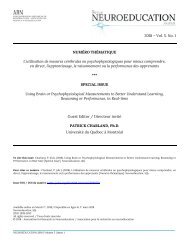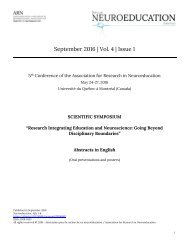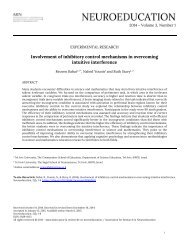Neuroeducation_2012_vol-1_no-1_full
Neuroeducation journal - Volume 1, Issue 1 (2012) - 144 pages
Neuroeducation journal - Volume 1, Issue 1 (2012) - 144 pages
Create successful ePaper yourself
Turn your PDF publications into a flip-book with our unique Google optimized e-Paper software.
Netten and Germain<br />
A new paradigm for the learning of a second or foreign language<br />
Since cognitive neuroscience has shown that highly contextualized learning<br />
(TAP) translates into more effective learning (Segalowitz, 2010), the learning<br />
of explicit aspects of language (i.e. external grammar) has also been<br />
contextualized in the NLA. Not only is external grammar introduced after oral<br />
use, but also in a context. Language forms are first identified in the texts used<br />
for reading, and then are integrated into the learner’s personal compositions.<br />
With respect to teaching strategies, reading and writing are taught directly in<br />
the L2/FL, without any explicit reference to translation. The strategies used<br />
are similar to those used in the mother tongue classroom for literacy<br />
development, but with modifications required for the learning of a second<br />
language. Modifications pertain particularly to a greater emphasis on oral<br />
development before reading and writing, as well as a more intense oral<br />
preparation at the beginning of reading and writing activities. These changes<br />
de<strong>vol</strong>ve from the neurolinguistic concept of internal grammar. In an L2/FL<br />
classroom, students possess an internal grammar that is considerably more<br />
limited than that of students learning to read and write in their mother tongue.<br />
Extending internal grammar development through oral use of new or different<br />
structures in the L2/FL before reading and writing activities enables students<br />
to integrate these structures into their print-oriented activities without resorting<br />
to translation (Germain & Netten, 2005a; <strong>2012</strong>).<br />
For reading there are three phases: an oral pre-reading phase; the reading<br />
phase that has two or three exploitations of the text: one for the message,<br />
incorporating teacher modeling of the text and a<strong>no</strong>ther (at the beginning) to<br />
understand the new sound symbol relationships; and the third to observe, and<br />
formulate, grammatical relationships. Attention is focused on meaning and<br />
form at separate moments, as recommended by Lyster (2007), but in the NLA<br />
approach, meaning always precedes form-focussed instruction (Krashen,<br />
1981; N. Ellis, 2011). A post-reading phase integrates the new k<strong>no</strong>wledge<br />
with that already learned. Writing also follows the three phases, for similar<br />
reasons. Once new vocabulary and structures have been appropriated in this<br />
sequence, they are then re-used in reading and oral activities to integrate<br />
them into the language that has been previously acquired. In this way,<br />
language learning from a literacy perspective begins and ends with oral use.<br />
Error correction remains important in the teaching of reading and writing. For<br />
reading, the teacher models fluent reading of a text, that is, linking together<br />
words in groups that have meaning. Students are encouraged to read in a<br />
similar fashion, as fluent reading aids comprehension. This process occurs<br />
more easily when learners have already developed an internal grammar. For<br />
accuracy, it is important that learners recognize the sounds of the L2/FL in<br />
their written form and produce or read them correctly. If incorrect connections<br />
ISSN: 1929-1833 © <strong>2012</strong> <strong>Neuroeducation</strong> – December <strong>2012</strong> | Volume 1 | Number 1<br />
98








